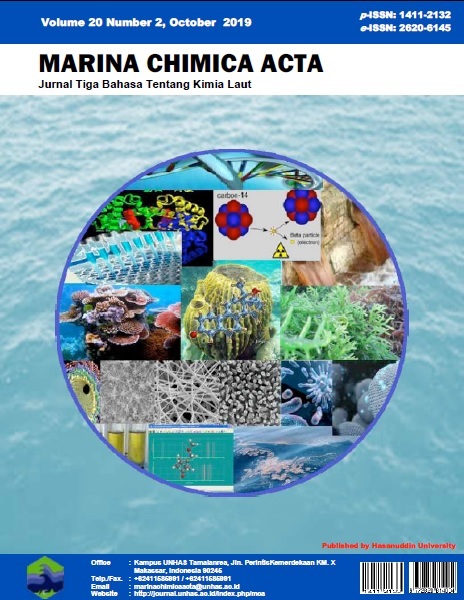CHARACTERIZATION OF SEA GRAPES (Caulerpa lentillifera) FROM VIETNAMESE COMPANY’S PRODUCTS
DOI:
https://doi.org/10.20956/mca.v20i2.9270Abstract
Species of sea grapes (Caulerpa spp.) are consumed broadly in many regions such as in Southeast Asia and Pacific areas. However, it damages easily if packed incorrectly and may only last for couple of days. A company in Vietnam (Tritin Pty Ltd) has developed a preservation technique for sea grapes that enables export to many countries. The aim of this study is to characterization of the Vietnamese company’s product of Caulerpa. The study found that the product based on a 10% brine concentration (114.33 g/L ±2.30 SD). The average weight of each sachet package is 22.47 g ±0.37 containing 65 fronds of Caulerpa lentillifera. The average weight and length of the fronds is 0.73 g ±2.30 SD and 7.27 cm ±1.59 SD. There was a significant relationship between the weight and the length of the fronds during the rehydration process in freshwater (R2=0.35, p<0.01), with rehydration of weight and length complete after x secondsDownloads
References
Lako, J. V. (2012). Value adding and supply chain development for fisheries and aquaculture products in Fiji, Samoa and Tonga: seagrapes post-harvest and value addition in Fiji: progress report: Institute of Marine Resources, FSTE, USP.
McHugh, D. J. (2003). A guide to the seaweed industry. Rome: Food and Agriculture Organization of the United Nations.
Chapman, V. J., & Chapman, D. J. (1980). Sea vegetables (algae as food for man). In Seaweeds and their Uses (pp. 62-97). Springer Netherlands.
Trono Jr, G. C. (1988). Manual on seaweed culture. 2: Pond culture of Caulerpa and 3: Pond culture of Gracilaria.
Hong, D. D., Hien, H. M., & Son, P. N. (2007). Seaweeds from Vietnam used for functional food, medicine and biofertilizer. Journal of Applied Phycology, 19(6), 817-826.
Kumar, M., Gupta, V., Kumari, P., Reddy, C. R. K., & Jha, B. (2011). Assessment of nutrient composition and antioxidant potential of Caulerpaceae seaweeds. Journal of Food Composition and Analysis, 24(2), 270-278.
Matanjun, P., Mohamed, S., Mustapha, N. M., & Muhammad, K. (2009). Nutrient content of tropical edible seaweeds, Eucheuma cottonii, Caulerpa lentillifera and Sargassum polycystum. Journal of Applied Phycology, 21(1), 75-80.
Paul, S., Nicholas, A., Tseng, C. K., & Borowitzka, M. (2013). Seaweed and microalgae. Aquaculture, Second edition, 268-293.
Aguilar-Santos, G., & Doty, M. S. (1968). Caulerpa as food in the Philippines. Philippine Agriculturist, 52, 477-482.
Australian Centre of International Agriculture Research. (2015). Diversification of smallholder coastal aquaculture in Indonesia. Final Report.
Chiralt, A., Fito, P., Barat, J. M., Andres, A., González-Martınez, C., Escriche, I., & Camacho, M. M. (2001). Use of vacuum impregnation in food salting process. Journal of Food Engineering, 49(2), 141-151.
Black, W. A. P. (1955). The preservation of seaweed by ensiling and bactericides. Journal of the Science of Food and Agriculture, 6(1), 14-23.
Moen, E., Larsen, B., Østgaard, K., & Jensen, A. (1999). Alginate stability during high salt preservation of Ascophyllum nodosum. In Sixteenth International Seaweed Symposium (pp. 535-539). Springer Netherlands.
Paul, N. A., Neveux, N., Magnusson, M., & De Nys, R. (2014). Comparative production and nutritional value of “sea grapes”—the tropical green seaweeds Caulerpa lentillifera and C. racemosa. Journal of applied phycology, 26(4), 1833-1844.
Novaczek, I. (2001). A guide to the common edible and medicinal sea plants of the Pacific Islands (Vol. 3). University of the South Pacific.
Paul, N. A., & de Nys, R. (2008). Promise and pitfalls of locally abundant seaweeds as biofilters for integrated aquaculture. Aquaculture, 281(1), 49-55.

